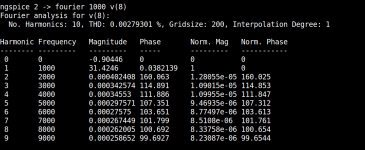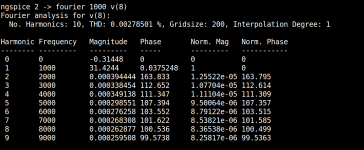 I've removed some personal and OT posts. Please keep your private disputes off this forum. No further warnings.
I've removed some personal and OT posts. Please keep your private disputes off this forum. No further warnings.Andrew,
Take a look at Arturo's amp which I have attached.
You know a thing or two about amp design.
Now examine Arturo's design with care and tell me with confidence that he is in clear error concerning thermal drift and output offset.
I think you will realise that Arturo is an exceptionally talented designer, and this design covers just about every base in linear audio amp design. It is smart to know where he is coming from before you comment critically.
Arturo used a Volterra Series to analyse one of my amp designs. The results were amongst the best theoretical analyses I have ever seen from an EE. He was able to identify all poles and zeros, and even predict the fundamental distortive mechanisms in a very complex amp with four feedback loops. I have never seen this sort of skill before, not even from some of the greats on this forum, with most of them pleased to demonstrate their capabilities in depth from what I can work out. Conclusion: Be circumspect, watch, and listen. This guy is the goods, take careful note.
Hugh
Take a look at Arturo's amp which I have attached.
You know a thing or two about amp design.
Now examine Arturo's design with care and tell me with confidence that he is in clear error concerning thermal drift and output offset.
I think you will realise that Arturo is an exceptionally talented designer, and this design covers just about every base in linear audio amp design. It is smart to know where he is coming from before you comment critically.
Arturo used a Volterra Series to analyse one of my amp designs. The results were amongst the best theoretical analyses I have ever seen from an EE. He was able to identify all poles and zeros, and even predict the fundamental distortive mechanisms in a very complex amp with four feedback loops. I have never seen this sort of skill before, not even from some of the greats on this forum, with most of them pleased to demonstrate their capabilities in depth from what I can work out. Conclusion: Be circumspect, watch, and listen. This guy is the goods, take careful note.
Hugh
Attachments
Last edited:
Andrew,
Arturo used a Volterra Series to analyse one of my amp designs. The results were amongst the best theoretical analyses I have ever seen from an EE. He was able to identify all poles and zeros, and even predict the fundamental distortive mechanisms in a very complex amp with four feedback loops. I have never seen this sort of skill before, not even from some of the greats on this forum, with most of them pleased to demonstrate their capabilities in depth from what I can work out. Conclusion: Be circumspect, watch, and listen. This guy is the goods, take careful note.
Hugh
Volterra series - Wikipedia, the free encyclopedia
That's the "goods" , as you say.
I simmed the above amp , and it even surpassed that "halcro like" amp of mine at 100k with 2-3ppm. I don't think Artu has built it yet , but it is quite an original design. Very impressed .
OS
Hugh, thank's for your fiery defence (you know that I don't need it... I feel a little embarrasment, always trying be low profile ...). so didn't feel too much offence about AndrewT reply ... all of this is about helping Pete's request for his new design on how to stabilize DC offset drift
Cheers
Arturo
Cheers
Arturo
Yes, I am building it at my pace, I hope next week to have the pcb finished, I could never surpass Pete's building proficiency (it's a madness !!!) ...
Cheers
Arturo
Cheers
Arturo
Every time I consider building something, I usually get an idea for a better design right when I'm ready to order the parts.
- keantoken
- keantoken
Every time I consider building something, I usually get an idea for a better design right when I'm ready to order the parts.
- keantoken
.....and right now I'm looking at a couple of OS amps plus the artu design (sweeeeeet one!!!) - a pre - a music server - perhaps a TT and tonearm project - and a speaker project for some Alpair 10's. Sigh - if I try to much at one time I'll need to figure in the cost of a marriage counselor or divorce attorney. Must - go - slooooooooooow - and make one project look as if it is simply a continuation of the previous project. If I can fit everything into one box I have a chance. 🙄
Well, I hate to continue a threadjack, but what do y'all think about this:
http://www.diyaudio.com/forums/solid-state/169590-mongrel-supersym-ii-22.html#post2407669
If there is interest in discussion I will start a new thread.
- keantoken
http://www.diyaudio.com/forums/solid-state/169590-mongrel-supersym-ii-22.html#post2407669
If there is interest in discussion I will start a new thread.
- keantoken
Andrew,
Take a look at Arturo's amp which I have attached.
You know a thing or two about amp design.
Now examine Arturo's design with care and tell me with confidence that he is in clear error concerning thermal drift and output offset.
I think you will realise that Arturo is an exceptionally talented designer, and this design covers just about every base in linear audio amp design. It is smart to know where he is coming from before you comment critically.
Arturo used a Volterra Series to analyse one of my amp designs. The results were amongst the best theoretical analyses I have ever seen from an EE. He was able to identify all poles and zeros, and even predict the fundamental distortive mechanisms in a very complex amp with four feedback loops. I have never seen this sort of skill before, not even from some of the greats on this forum, with most of them pleased to demonstrate their capabilities in depth from what I can work out. Conclusion: Be circumspect, watch, and listen. This guy is the goods, take careful note.
Hugh
Hi, Hugh
There s nothing to criticize over this topology, and it happens
that i use one that is close, although with a different general
design stand point, but what about its implementation ?..
Have you made some sims about it to have a look at its behaviour?..
If you had done so, you should have noticed that the input differentials
degeneration is way to weak, with a high transconductance,since the
tail current is about 12mA...
Their values should be increased significantly as with 3.3R, it will oscillate
with certainity, unless the comp caps are significantly increased
from their current 27pf values that are low considering the input
stage current capability..
The differentials CCS reference voltages are slightly floating since it allow
the DC servo to control the current through the references.
A drawback is that DC variations will change the reference voltage,
leading to variations in the tail current, thus output dc offset will
be varying with output loading while the dc servo will be way too
slow to control this dynamically tighted offset...
cheers,
w
Hi Wahab, (I am the author), the amp is stable (in theory, as I am building it and will take me a while to bring it to real), I simmed it very carefully in several different conditions (even adding lumped parasitics at critical points, and models imbalance), clipping over the hole BW (1 - 10 MHZ), with input signals 150% to 300% the maximum normal which is 3Vpp, and with ridiculous hign dv/dt. input impulses. I short I can say that the 330p caps acts as high frequency dumpers and improves ac stability, without sacrificing too much bandwidth (and distortion), and allow to use a very little degeneration which also improves overall distortion and allows such little Cdom 27pf as you pointed, that way it can achieve 200V/usec slew rate. The DC servo acts mainly biasing thermal drift (also simmed with very low frequency asynchronous signals), but in some way you are correct, it is not perfect, the circuit itself is stable in DC conditions, so the floating condition of the CS's is limited. I can send more detailed information if you wish by other means in a document I am working, but it will take me a while.
Cheers
Arturo
Cheers
Arturo
Member
Joined 2009
Paid Member
I have found that amplifier stability is not always guaranteed through simulations - unless you have wide design margins (and don't rely on an 8Ohm load in your simulations, add 10nF of capacitance go ground for example). Some on-the-bench adjustments to compensation are often desirable for tuning the sonics too.
Yes Bignum, I've also used several complex loads (speakers models), but you are right, simulations are not perfect, anyway I have a big room to avoid unstability, with too much sacrifice it's inherent goods, that will be verified in practice, my take is that it will be very close.
Cheers
Arturo
Cheers
Arturo
Hi, Artu
There was no pun intended, and anyway, since i prefer
this kind of topology, i can only encourage you to go in
that direction.
That said, if you are building it, just be carefull to increase
the said degeneration in your first live tests, one never knows..
As for other details, contrary to the one mentionned, they will
unlikely prove dangeourous with a real implementation.
Cheers
w
There was no pun intended, and anyway, since i prefer
this kind of topology, i can only encourage you to go in
that direction.
That said, if you are building it, just be carefull to increase
the said degeneration in your first live tests, one never knows..
As for other details, contrary to the one mentionned, they will
unlikely prove dangeourous with a real implementation.
Cheers
w
Thank's Wahab for your advices, I know that I must start slowly, greed is a sin ...
Cheers
Arturo
Cheers
Arturo
Sorry Os for the noise, but since you are starting a similar topology project, your Leach I thought that some replies I've made could be useful for you. BTW I've downloaded your Leach to sim it. Soon I'll post my findings. I'll stay polite with your thread.
Cheers
Arturo
Cheers
Arturo
I'm hoping to make some AX boards over the break, I'm also going to replace my PSU tx to get 58v (only have 38v at the moment) rails and add the cap multiplier to the output boards. Oz, any chance of updating your website with the AX boards.
Thanks Pete
Thanks Pete
I'm hoping to make some AX boards over the break, I'm also going to replace my PSU tx to get 58v (only have 38v at the moment) rails and add the cap multiplier to the output boards. Oz, any chance of updating your website with the AX boards.
Thanks Pete
I will release all on the new year , even the soon to be completed CLX1.0 (artu's amp).
I now have:
1 -softstart , SS20
2- power supply boards , PS50 and 100
4- Output boards , PB250H and N , PB120 ,and PB60X2 (stereo demo amp).
4- voltage boards, AX/BX and CLX / LX (I will design the original leach VB).
Most are "alive" (working and tested /abused) , so a actual picture overview with values/voltages. very DIY "friendly".
So , wait till 1/1 , you shall receive. Ahh , heres the PCB .. if you must do it soon.
OS
Attachments
Last edited:
- Home
- Amplifiers
- Solid State
- The MONGREL (supersym II)


